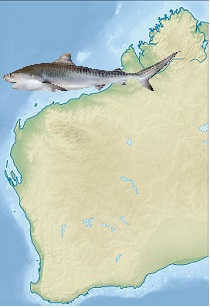Cause for optimism over non-reef shark numbers off North West WA
Media Release
Department of Fisheries, Western Australia
29. July 2020
— — — — — — — — —

Reliable information for population assessments is rare for sharks, but fisheries researchers from the Department of Primary Industries and Regional Development (DPIRD) have been building a data rich study of non-reef species since 2002.
The latest patterns in abundance of sharks off Western Australia’s North West coast show that resource use, recovery and conservation outcomes can be achieved when science, management and enforcement work have the goal of sustainability.
Shark species play a vital role in the marine food chain, both as prey and predator and are an indicator of a healthy ecosystem. Without the balance they provide in the marine environment and amongst their oceanic competitors, the food chain below them may not be under control.
Unlike other parts of the world, where high fishing pressure has led to decline in many shark populations, WA fisheries scientists have found catch rates and average size of the non-reef species sampled in their regular surveys have been either stable or increased in recent years.
Data from the most recent survey between Carnarvon and Broome shows 43 shark and ray species were recorded. Sandbar shark were the most commonly-caught species, followed by milk, spot-tail, tiger, blacktip, dusky and sliteye sharks, and scalloped hammerhead.
Senior DPIRD researcher and lead scientist in the most recent survey off the North West coast, Dr Matias Braccini said the global research released last week on reef sharks has demonstrated that Australia has been one of several nations where shark conservation on coral reefs has worked.
“The same is true for non-reef sharks in that management controls, which have reduced fishing pressure have shown tangible results from the regular sampling we’ve done,” Dr Braccini said.
“When science, management and compliance come together, sustainable resource use, recovery and conservation outcomes can all be achieved.”
Based on the increase in abundance of sandbar sharks noted in this survey combined with the stable trends in the mean (or average) size all species, Dr Braccini said we could be optimistic about the benefits from management measures put in place by the department.
“It’s important because we know that declines in average size are strong signs that the fishing rate is too high for a stock to sustain in the long term. However, this not the case for the sharks sampled during our most recent survey,” he said.
“Sustainability is possible for non-reef shark species, when balanced measures are adopted.”
Dr Braccini said losses of line caught fish due to depredation by sharks (otherwise known as bite-offs) has been a significant issue for many recreational and commercial fishers. Research by DPIRD scientists, using genetic techniques, has revealed that a variety of shark species, including reef sharks and non-reef sharks, are involved in depredation.
“A range of shark deterrent devices are currently being tested at various locations from Abrolhos to Exmouth and the Montebello Islands, through a grant from the Recreational Fishing Initiatives Fund,” he added.
The next non-reef shark survey of North West coast will take place in 2021, to help maintain Western Australia’s unique stream of shark abundance information.
Source: Government of Western Australia
